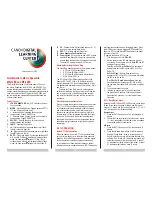
V1.02
Thom Hogan’s Complete Guide to the Nikon D300
Page 305
potentially about 11-12 stops of dynamic range). In other
words, try
5F 1 .0
as your bracketing setting.
•
Focus should be set to a specific point (manual focus),
Auto ISO should not be used, avoid Auto white balance,
the camera should be on a tripod, and all camera settings
other than shutter speed should not vary between shots.
Assuming you pay attention to these details, you’ll get
astonishing tonal ramps and any residual digital noise will
tend to disappear (this is most noticeable in shadow detail,
which tends to be impeccable using this method). Indeed, the
combination is so good that I recommend that Fine Art
photographers shooting for large prints use Photoshop’s
Merge to HDR
and five or seven shot NEF bracket sequences.
The question that usually gets asked next is “how to I do an
automatic bracket with a single shutter press? Simple:
combine it with Interval shooting (just make sure the number
of pictures at an interval matches your bracketing depth; see
“Interval Shooting” on page <440>).
When your camera is set to bracket, a few details sometimes
catch new D300 users by surprise:
• In the Continuous release shooting method, holding down
the shutter release attempts to take only the specified
number of photos in the bracketing sequence (i.e. either 2,
3, 5, 7, or 9). The camera automatically stops at the end of
the bracketing sequence, regardless of whether you
continue to hold the shutter release down (it might stop
earlier if you run out of card space).
• In the Single frame shooting method, you must press the
shutter release once for each picture in the bracketing
series. If you turn the camera
Off
in the middle of a series,
it remembers that when you turn it back
On
(i.e. you’re
still in the middle of a bracketing sequence, no matter
how long an interval has transpired). The same thing is
true if your CompactFlash card fills up in the middle of a












































